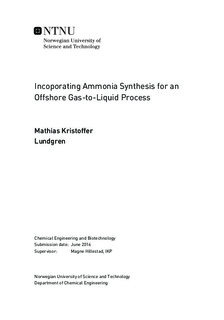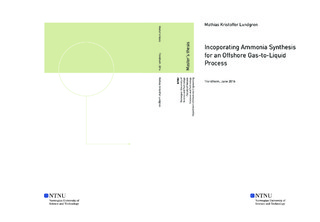| dc.description.abstract | The world energy demand is increasing, and so is the demand for fertilizer to
sustain an exponential population growth. Currently, with low oil prices, asso-
ciated natural gas is flared off or re-injected into oil reservoirs for enhanced
oil recovery (EOR). A gas-to-liquid process (GTL) for offshore applications
aboard a foating production, storage, and offoading vessel (FPSO) incorpo-
rating Fischer-Tropsch Synthesis (FTS) seeks to reform natural gas into more
valuable liquid products. As the composition of natural gas feeds varies greatly
depending on location and other factors, a surplus of hydrogen production is
maintained in order to have a steady production of the desired FTS products.
An alternative use for this surplus hydrogen is in ammonia synthesis, which in
a relatively simple process design using readily available streams in the GTL process, can
produce considerable amounts of ammonia.
A complimentary design to an existing GTL process designed for offshore appli-
cations which seeks to incorporate ammonia synthesis is proposed. Two possible
designs are tentatively suggested and evaluated, each design utilising different
streams in the GTL process with a high nitrogen content, in addition to the
surplus hydrogen stream in the GTL process. The process design features a
synthesis loop, as well as removal of compounds containing oxygen, such as
CO2 and water, as these compounds are poisonous to the ammonia synthesis
catalyst. The ammonia synthesis reactor is simulated as three separate beds,
with a refrigeration loop to cool the stream exiting the reactor to sub-zero tem-
peratures in order for ammonia to condense and be separated from the synthesis
loop. Uncondensed ammonia and unreacted hydrogen and nitrogen gas is recy-
cled and reintroduced to the reactor.
Two separate process designs were simulated in Aspen HYSYS V8.6, each with
a different source of nitrogen. The basis for the nitrogen sources for the ammo-
nia synthesis process are the streams pertaining to the GTL process proposed
by Hillestad et.al. Two different kinetic models were also evaluated. Heat
integration is performed in Aspen Energy Analyzer V8.6, and a heat exchanger
network (HEN) is proposed.
The best process design features the N2 -rich stream from the membrane in
the air enrichment unit in the GTL process, as this offers a simpler process
design compared to utilising the tailgas from the GTL process. The system is
optimised using the Temkin-Pyzhev kinetic model for the ammonia synthesis
reactor. The power-optimal operating pressure is found to be approximately
235 bar, while the optimal operating temperature is found to be approximately
415 ◦C depending on the reaction bed.
After heat integration, the process requires no external heat source, and the
system power demand is suffciently low to be met by the gas turbine in the
GTL process. The process converts 1889 kgmol/h of unprocessed hydrogen/CO2
stream from the hydrogen selective membrane in the GTL process, and 613 kg-
mol/h of nitrogen/oxygen stream from the air enrichment unit to produce 1167
kgmol/h, or 19.9 tons/h, of ammonia. The total investment cost of the proposed
design is estimated to 87.6 million US$. | |

